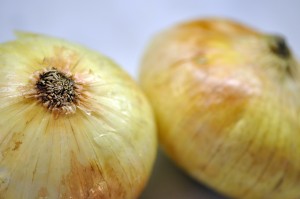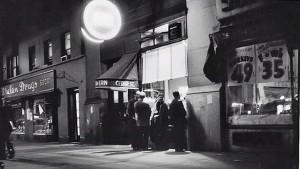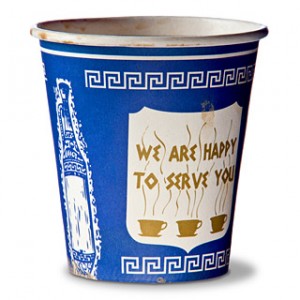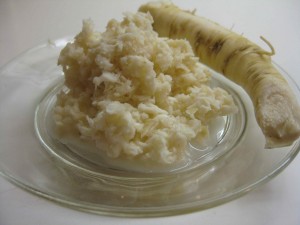BSK, a talented potter (among many other accomplishments and skills, both practical and artistic), has made a special pot for storing lemons, limes, oranges and avocados. Out of this wonderful artifice, BSK extracted an avocado, squeezed it and announced: “I’ve got some Vidalia onions. Let’s have an onion-avocado-orange salad.” HG is a passionate lover of sweet Vidalias. Combining them with ripe avocado slices and blood oranges is a heavenly marriage that HG first tasted in a Cuban restaurant in northern Manhattan. No, they did not use pricey Vidalias, but ordinary onions — delicious nonetheless. When eating at this unnamed restaurant, HG accompanied this salad with fried shrimp or flounder or “ropa vieja” (a type of Cuban pot roast) or sometimes a slice of chewy but flavorful rare steak. Obligatory was a big bowl of “Moros y Cristianos” (Moors and Christians, a colorful name for black beans and rice). So, for the mutual delight of HG and BSK, this meal was reproduced last night. HG sizzled a garlic rubbed flap steak in a trusty cast iron pan. (Flap steak is a butcher’s secret. Cheaper than a conventional sirloin and full of beefy flavor). A can of Goya black beans (the best) was warmed and served atop white rice (adorned with plenty of chopped, raw Vidalia and splashes of picante salsa). There was a bottle of Rosemount Austrailan Shiraz (big and fruity). Django Reinhardt (circa 1936) on the Bose. Joy.
Vidalia Delight
May 22nd, 2013 § 0 comments § permalink
The Cedar Bar – The Good and The Bad.
May 21st, 2013 § 4 comments § permalink
The last remnants of the Cedar Tavern (always referred to as the Cedar Bar), 82 University Place in Manhattan’s Greenwich Village, are being demolished to make way for a waxing salon. Nostalgia can can cloud vision. But, not Lee Siegel’s vision. The writer has a very balanced account of Cedar Bar in a New York Times Op-Ed piece and comes to some surprising conclusions. Permit HG to review the Cedar Bar history. In the 1950’s and early 1960’s it was the hangout of the hard drinking, rambunctious New York school of abstract expressionists and other painters who became modernist icons — de Kooning, Rivers, Pollock, Kline, Guston, Motherwell, etc. Their presence attracted writers, film makers, poets, musicians and a motley crew of bohemians. It was a macho crew so there were plenty fisticuffs and alcohol fueled rage (and hilarity). Needless to say, misogynistic and homophobic language and behavior flowed free. Siegel points out that women were always treated badly. He quotes Lee Krasner, Jackson Pollock’s wife and an extraordinary painter in her own right: “I loathed Cedar Bar. Women were treated like cattle.” Gays were insulted and made uncomfortable. One saving grace of the Cedar was it was very inter-racial. It was a bar where HG always felt comfortable drinking with his African-American girl friends. (Yes, women were treated shabbily. But, not African-American women. The Cedar’s ferocious leftists saw to that.)
HG was a man of his time. HG loved the Cedar Bar and shared most of the nasty attitudes of its habitues. When HG lived in the Gramercy Park neighborhood (more than 50 years ago) HG had a Saturday routine. Little daughter Victoria (now the distinguished restaurateur — Five Points, Cookshop, Hundred Acres) was placed in her stroller and the duo was off on a stroll through 23rd Street (great bookshops), Gramercy Park (HG had a key for a short period), Irving Place (a grilled cheese sandwich for little Vicki at Pete’s Tavern), Washington Square Park and, as a final destination before returning home, Cedar Bar. Vicki was perched on the bar where she munched pretzels and peanuts and was admired by all for her remarkable blonde cuteness. As for HG, there were numerous martinis while HG participated in vigorous discussion. A very boozy and joyful afternoon indeed.
Greeks
May 11th, 2013 § 2 comments § permalink
In one of the great quirks of the American immigrant experience (think Chinese laundries, Indian motel monopolies, Korean grocers, etc.) Greeks have long been the dominant force in New York and New Jersey’s numerous diners and coffee shops and, in fact, in inexpensive dining establishments throughout the U.S. and Canada. The domination is so ubiquitous that the iconic New York take-out coffee cup was long emblazoned with illustrations of classic Greek art and architecture. Unlike fancy Greek fish restaurants (or traditional Greek restaurants), these diners and coffee shops are not gourmet destinations or particularly ethnic, but places where you can get a fast, square meal at a fair price. New Jersey’s Tick Tock Diner (famed for its “Eat Heavy” motto) has been in the news lately. Owned by a Greek family, the Tick Tock has never been a favorite of HG. However, its proximity to the Lincoln Tunnel and Meadowlands sports and entertainment complexes has made it popular (location, location, location). The news interest in the Tick Tock now is a case of murder. It seems the manager (relative by marriage) felt ill used by the head of the family (and Tick Tock boss) and hired a hit man to torture and kill the guy. As is often the case, the hit man was an undercover cop (with a nicely functioning) recording device. Too bad for the manager. HG’s favorite Greek greasy-spoon operator was Chris, a sweet, hard working guy who–some 60 years ago– ran a hole in the wall operation in the old Daily Mirror building at 235 E. 45th Street in New York. Chris had a thick Greek accent. This made him a favorite of Dan Parker, the Mirror sports columnist, who would often quote Chris as part of his humorous riffs on dialect. Chris fed the impecunious journalists, lithographers, pressmen and others who worked in the building the inevitable “cheeburger, cheeburger, cheeburger.” But, Chris also turned out great fried scallops and fried flounder. Splendid greasy French fries. Chicken livers and onions on rice. Other good things. Not too many vegetables, unless you count cole slaw as a veggie.
As a side note, it is fascinating that some of America’s great regional cooking from Cincinatti Chili to Rhode Island’s New York System wieners to Detroit’s Coney Island Hot Dogs can be directly traced to the blending of classic American food and traditional Greek flavor profiles (middle eastern spices, etc.).
A Little Nosh
May 9th, 2013 § 0 comments § permalink
Many, many years ago, young newlywed BSK hosted a party (lots of showbiz folks) at HG and BSK’s spacious apartment (a former artist’s studio) on Manhattan’s W. 67th Street. The exuberant actress, the late Shelley Winters arrived and loudly requested a nosh. BSK had been a New Yorker for only a few months and her knowledge of Yiddish was zero (Now, after a half-century with HG, BSK could be a diva on a Second Avenue Yiddish stage). BSK was puzzled. Did loud Ms. Winters want a drink? Was a nosh an exotic variety of martini? Of course, what the loud lady wanted was a snack. Nosh is Yiddish for snack. Noshing (snack eating) was mostly non-existent in the HG boyhood home. Meals were capacious. HG had a modest bite after school (before four hours of violent and active street games) and a glass of milk and a graham cracker before bed. HG is always shocked to see the massively stocked snack aisles at supermarkets and shopper carts filled with salt and fat laden chips and crisps and crackers (plus disgusting sugar and chemical loaded soft drinks). The point has been made many times. The French eat lots of fat and butter. Wash it down with wine. No snacking. Stay slim. (It helps that French portions are much smaller than American and the non-autocentric population does a lot of walking).
Here’s another Shelley Winters anecdote (Obviously, HG cannot vouch for its authenticity. Show biz is replete with nasty anecdotes.): Her ardent lover at the time, an actor, returned from two weeks filming in South America and met Shelley for a quick meal before a lovers’ tryst. Shelley, a gourmand, kept lingering at the table. Her lover, furious, said:”Shelley, it appears you want to fill the wrong cavity.” The affair, needless to say, was over.
Ignoring Reviews and Loving Brooklyn Crab
April 28th, 2013 § 0 comments § permalink
SJ here. For the past year I gazed with a certain hesitant lust at Brooklyn Crab. As it was being built (and looking like an old-fashioned Fire Island beach house) I thought, as everyone probably did, what a smart idea! What a great view! Beer and Crabs overlooking the harbor. Pretty Simple. Pretty great! When it opened, it was immediately jam-packed — a complete and total success and I just never made it over.
This past weekend was glorious. Spring in all of Spring’s perfection — sun shining, dry breeze blowing and crisp as a freshly picked cucumber. I had friends coming and I thought how nice it would be to go to Brooklyn Crab, sit outside and take in those harbor views while drinking beer and eating crabs…And then I read the reviews. Man, Brooklyn Crab was so terribly reviewed that I almost called the whole thing off, but then I thought well, how bad could it really be? At least the beer should be cold and even eating some crappy peel and eat shrimp still seemed okay. So I geared myself up to not be upset by bad food and bad service and ended up going. After an hour-long wait (which was easy as I bought some wine at Red Hook’s great Dry Dock and took it out to the Louis Valentino Park and Pier) we were seated. The view of the harbor was brilliant and a kind of giddy, beach-side-vacationy-fun vibe suffused the whole place. It was precisely what I wanted. We ordered Maryland Crabs, some Steamers, a mixed seafood boil with shrimp, King Crab legs, corn, clams, potatos, etc and some fried shrimp. The Crabs were as good as those I had had in Baltimore and the Seafood Boil was done just right, nothing overdone and we had lots of fun and made a total mess cracking crabs and picking out the meat. Oddly the potato that was included in the Seafood boil was excellent! Perfectly cooked and infused with the Old bay seasoning and the briney flavors of the crabs and clams. The fried shrimp were mediocre and the steamers weren’t the best I ever had, but there was tons of food and between five people we managed to eat everything and really enjoy ourselves. No it wasn’t the greatest seafood meal of my life by any means, but it was totally respectable and just totally jolly. I also enjoyed what a nice cross section of Brooklyn were eating there AND working there — real Brooklyn families from Irishy looking Cop families to Asian familes from Sunset Park to Jamaican families to twenty somethings on dates and nary a hipster in sight to complain about the lack of locavore credentials. In many ways, Brooklyn Crab reminded me of the blue collar seafood spots in City Island — no pretensions at all. The prices were not cheap but they weren’t insane. And when we finished, the Manger (I’m guessing) came over and asked us how everything was. I told her we had a great time and told her that I was worried before we came because the reviews were so crappy. And she sort of said, yeah, it was a bit of a struggle last year but they were really trying to improve…and I could think was yeah, you did! So if you want to eat some crabs, drink some cold beers and overlook perhaps the greatest urban water view outside of Istanbul, then turn away from the reviews because Brooklyn Crab hits the spot.
The West Side Is (was) The Best Side
April 15th, 2013 § 0 comments § permalink
HG has written frequently about the food heaven that was the Upper West Side of Manhattan. Yes, Zabar’s, Murray’s and Barney Greengrass remain — temples of smoked fish and other delicious treats. But, in the days long before the UWS became fully gentrified there were scores of Mom-and-Pop shops, eccentric ethnic restaurants and corner greengrocers that defined the neighborhood’s culinary bent — all have disappeared, crushed by the real estate steam roller. When HG and BSK lived on the West Side during the 1960s and early 1970s the neighborhood was a bastion of rent control. Vast, affordable apartments were legion. Naturally, this attracted writers, artists, musicians, dancers, intellectuals, etc. The neighborhood had an edge. There were plenty of muggers and drug addicts. Petty larceny was the norm. Crazies, huddled in layers of clothing during the warmest weather, wandered the streets mumbling their interior monologues. At night, hookers appeared. There was a melancholy haze over the benches on Broadway where Holocaust survivors, often displaying their concentration camp tattoos, sat ringed in exhaust fumes and polluted sunshine. The great, Nobel Prize-winning author I.B. Singer, a small, pale man in a dark suit and fedora, would chat in Yiddish with these men and women (when he wasn’t feeding pigeons). Impecunious old European refugees favored the Senate Cafeteria on Broadway near 96th Street where they argued endlessly over cups of tea. HG and BSK lived in The Hereford, a moldering 12-story apartment house between West End Avenue and Riverside Drive (glorious views of the Hudson River and the New Jersey Palisades). The building was a repository of the arts. HG and BSK’s dear friend, the composer Michael Small lived with his wife, Lynn, on the fourth floor (HG and BSK lived on the lofty 12th). The Small’s apartment was unusual. Michael’s classmate at Williams College, Charles Gwathmey, the extraordinary architect, had ripped out walls in the apartment creating an exuberant space defined by his beautifully crafted cabinetry. Michael’s grand piano was at stage center. Peter Boyle, the actor (before jumping to fame in Young Frankenstein) lived in the building and joined HG and BSK at a Chinese cooking class. Ted Solotaroff, the visionary critic and editor (founder of The New American Review and lifelong friend of Philip Roth) became a pal of HG and BSK. Here’s a vignette of life at The Hereford: Early one evening Michael summoned HG and BSK to his apartment where he played some of his score to the film Klute (a hit with Jane Fonda as a call girl-in-peril). He went on to write the scores for many memorable films induing All The President’s Men and Marathon Man. After dinner we all went to a literary event at Ted Solotaroff’s apartment. Here, we heard Richard Howard, the poet and translator, read Robert Browning’s My Last Duchess. Memorable. Sadly, Small, Boyle, Gwathmey, Singer and Solotaroff are all gone. Richard Howard is still a figure in New York literary life. And HG continues to remember it all with great fondness.
Woody Allen’s New York
April 11th, 2013 § 0 comments § permalink
In the early 1950’s, a scrawny kid named Alan Konigsberg was writing gags for New York press agent David Alber. Alber, of course, would submit these little bon mots of humour to the reigning Broadway columnists in exchange for mentions of his clients. At the same time, HG (in his morally conflicted role as journalist and moonlighting press agent) was writing gags and newsy tidbits for the columnists (Walter Winchell, king of the columns, liked HG’s stuff). As HG has often remarked: “I went on to fame and fortune. Wonder what happened to the Konigsberg kid?” Well, Konigsberg changed his name to Woody Allen and has been busy lighting up the world with his comic genius for more than 50 years. These were some HG memories last night as HG and BSK watched Whatever Works, the Allen comedy starring Larry David. Allen originally wrote the movie with Zero Mostel in mind but Mostel died before it could be made. It would have been better with Mostel. Larry David, a gifted comedy writer and a funny man in his improvised riffs on the television program Curb Your Enthusiasm, is not a film actor and can’t really carry a movie. Zero, a mad comic monster, would have been a smash. Still, HG enjoyed the movie because, once more, Woody Allen displayed his intense love for New York. Lots of Greenwich Village street scenes and Chinatown food shopping (lovingly photographed). There’s even a vignette featuring the Yonah Shimmel knish shop on Houston Street. In Allen’s New York everyone seems to live in great apartments or lofts. There’s lots of dining in pleasant restaurants. Best of all, beautiful shiksas (non-Jewish girls) find neurotic, verbal, physically unprepossessing Jewish guys sexually irresistible. As the saying goes: “From Allen’s mouth to God’s ear.” But, maybe Woody has a point. After all. HG met and won the heart of BSK in New York.
At Last: A Jewish Delicacy Breakthrough
April 5th, 2013 § 7 comments § permalink
Many, many decades ago when HG was a young New York journalist, HG would join a raffish crowd of late night drinkers at Moe Dubiner’s bar/restaurant on Stanton Street (years before the Lower East Side became cool and trendy). The cuisine was Eastern European Jewish, relished alike by the Irish policemen and the Jewish mob guys and bail bondsmen who made the joint their hangout. HG’s nocturnal snack at Dubiner’s was a big plate of gefilte fish (for the unknowing–this is a type of robust quenelle of minced whitefish and carp poached in fish broth) accompanied by challah, rye bread, pickles and copious amounts of very strong horseradish. Four Roses rye whiskey and beer chasers. These tastes of yesteryear have, thankfully, been rediscovered. Kedem Gourmet Gefilte Fish from Israel (available at Whole Foods) is the real thing. As the label says: “No MSG. No egg yolk. No matzo meal.” The Kedem product has the right density and no sweetness. Its appropriate companion is Lou’s Famous Organic Horseradish. Most bottled horseradish is insipid and tasteless. Not Lou’s. This is powerful stuff with a real bite that must be used with a degree of caution. Clears the sinuses and makes HG feel young again.
Speaking About the Unspeakable
March 30th, 2013 § 0 comments § permalink
Natural functions being what they are, the bathroom (also known as the sanitary facility, the toilette, the Head, the W.C or the stately “Gentlemen’s Lounge”) is a necessary adjunct to dining, movie going and other pleasurable activity. In HG’s experience, the vilest bathrooms can be found in New York’s Chinatown. The smallest are in coffee bars in Italy. The most inconvenient are in Paris bistros where they are often tucked away in a subterranean alcove. The most luxurious can be found in the best London hotels like the Connaught, Savoy and Dorchester. The Oak Room of the Plaza Hotel in New York had a splendid bathroom supervised by a deft and distinguished attendant (The Plaza has undergone vast changes and HG hasn’t visited the Oak Room for decades so this may no longer be true). HG had a memorable experience in that bathroom. The super debonair actor Cary Grant (a frequent Oak Room diner) entered the bathroom with HG. Unlike HG, he did not remove his jacket. Instead, Grant unbuttoned the buttons on the jacket’s sleeves, did a quick fold and washed his hands. HG was dazzled, having long believed that sleeve buttons were merely decorative. From that time on, HG went to the extra expense of having his suit jackets tailored with operable buttons. The most architecturally distinguished bathroom HG ever encountered was the art deco masterpiece in New York’s Radio City Music Hall. In HG’s recollection, its walls had a mural extolling smoking and tobacco cultivation. It was also the first bathroom with a warm air blower for drying hands. Little HG found this innovation as exciting as any movie and spent far too much time drying and re-drying his hands. Bathroom attendants were usually anonymous personalities, obsequious gents who trolled for tips while handing out towels — but not the old guy at the Polo Grounds, the rickety old uptown New York stadium that once housed the baseball and football NY Giants. He regaled his customers with this bit of doggerel: “No matter how you shake and dance, the last drop always falls in your pants.” And he was not shy about promoting tips, singing out “After you’ve had your little pee, don’t forget to remember me — old Sam.”
They Tried To Kill Us. They Failed. So, Let’s Eat A Lot And Get Drunk.
March 23rd, 2013 § 2 comments § permalink
Passover is here. Matzos sit next to Easter Bunnies on supermarket shelves across America. It’s that time of year. Boisterous eating and drinking dominated HG’s family Passover celebration, the Seder, when some 76 years ago much of HG’s family was centered in the Flatbush section of Brooklyn. Though a very young lad then, aged HG still remembers all the details of the raucous family feast. First, a small glass of wine and a tiny plate of food was placed on the table for the prophet Elijah (in the unlikely event that he would manifest himself in Brooklyn). The table was set with the symbolic dishes (these were not eaten) of the Hebrew captivity in Egypt. There was the reading of the Hagaddah, the tale of Passover (In those long ago days, the Hagaddahs were published by the Maxwell House Coffee Company. They were distributed, free of charge, at Jewish “appetizing” stores and kosher butchers. A canny PR move by the coffee merchants). A matzo (the traditional unleavened bread obligatory during Passover) was folded into a napkin and “hidden.” This was called the afikomen and when found by the young members of the family each got a monetary award — a shiny half-dollar. (Many years later, HG learned that when the lucky children of one of HG’s real estate mogul public relations clients found the “afikomen” each were rewarded with a $10,000 check). The big moment for little HG was when he was called upon to ask “the four questions” — the inquiry as to why this celebratory Passover night was different from any other night of the year. The small boy relished the spotlight and asked the questions — spoken in English and chanted in Hebrew — with many bravura, theatrical flourishes. “A regular Thomashefsky!!,” HG’s uncle exclaimed, approvingly. (Boris Thomashefsky was a flamboyant star of the Yiddish stage. The conductor Michael Tilson-Thomas — who shortened the name — is his direct descendant). The serious eating began with copious portions of gefilte fish (a very robust version of the French “quenelle”) with heaps of fiery, freshly grated horseradish. Followed by brisket, copious gravy, roasted carrots and onions plus knaidels — matzo meal dumplings which had a sponge like capacity for soaking up gravy. All of this was accompanied by many glasses of kosher-for-passover Schapiro’s sweet Malaga grape wine (purchased at the Schapiro lower east side winery – now closed). The wine carried a kick so the Seder became louder and more irreverent as the evening progressed. Dessert was a compote of stewed fruit plus special Passover pastries like coconut macaroons. Bottles of Vishniak (cherry brandy) and Slivovitz (plum brandy) appeared and were drunk in abundance. A Seder song, Chad Gadya, a song about the survival of a symbolic kid, was sung and shouted — loudly. More songs. Some secular and even naughty. More brandy drinking. At one memorable Seder, the group was singing: “We love Jesus, yes we do. We love Jesus, yes we do. Hooray for Jesus. Hooray for Jesus. Damn good Jew!!” Two very Irish looking cops appeared at the door. Asked the family to tone things down. Neighbors were complaining. Invited the cops to have a drink They agreed. Big glasses of Slivovitz. HG’s cousin proposed a toast: “To Ireland, a great land.” More Slivovitz and the cops joined in the next toast, shouting with the family, “Next year in Jerusalem.”









